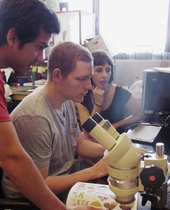Highlight
The butterfly guide: a mobile tool for natural history education and biodiversity informatics
Achievement/Results
The next time you see a butterfly in Northern California, you may be able to identify it with the help of a mobile phone app being developed by University of California, Davis, graduate student Melissa Whitaker.
Whitaker, a doctoral student in ecology supported by the NSF-funded Responding to Rapid Environmental Change IGERT, worked with computer science undergraduates Joey Jiron and Bryan Maass to create a mobile tool that is part field guide, part data portal, and part education hub. The result will be an app that allows for the seamless acquisition, synthesis, and dissemination of biological information by students, naturalists, and citizen scientists.
Online biodiversity databases have become an important tool for biologists as data repositories and sources of information about organisms and their natural history. Several of these provide opportunities for interested members of the general public to help build databases by providing local observation data. Whitaker’s project will become part of this informal consortium.
Whitaker’s butterfly guide includes three main components. The first, in the style of a traditional field guide, provides information about each butterfly species, its natural history, and photographs of adults, larvae, and eggs.
The second component consists of education modules that can be used in classroom or outdoor settings. These modules will use local butterfly examples to teach general concepts in ecology and biological conservation, such as such as migration, mimicry, hostplant specificity, climate change, habitat loss/land-use change, pollination, and regional natural history. Additional features may include information about butterfly gardening and habitat status. All features will be written for the layperson, but with enough detail to be educational for advanced amateurs and students.
In the third and most novel feature, the app will allow users to link with online data sources when they wish to find more information about a particular butterfly. A “Resources” page will direct users to other sources of information.
Finally, the app will allow users to create and manage their own species lists. This will include a field notebook function for writing notes and incorporating photographs about butterfly sightings, thus allowing the user to incorporate written notes, external links and sources, and photographs. Users also will be able to keep personalized lists of websites and links that they find relevant.
The app will be available to the public free of charge at several internet sites.
In addition to the undergraduate programmers, Whitaker is collaborating with Arthur Shapiro, noted expert on California butterflies and faculty member at UC Davis, Robert Stevenson of the Biodiversity and Ecosystem Informatics Lab at University of Massachusetts, Boston, and James Quinn, faculty member at UC Davis and director of the Information Center for the Environment.
Users also will be able to contribute to an online community hosted by Shapiro’s butterfly site, http://butterfly.ucdavis.edu/.
Address Goals
Whitaker’s smartphone app will turn a Smartphone into a mobile biodiversity tool accessible to members of the public. This simultaneously will provide them with accurate information and enable them to aid scientists in supplementing knowledge of biodiversity.
Whitaker commented, “The potential to use mobile technologies for education and citizen science is huge. This project excites me because it uses a standard device to help students and citizens engage more deeply in the natural world.”
In addition, the smartphone application will provide structure for a variety of educational activities. For example, teachers and students could design class projects documenting butterfly migrations, or amateur naturalists could organize community butterfly excursions.
Finally, development of the app required collaboration with two computer science undergraduates. This provided them with hands-on experience with a programming challenge and introduced them to ecological informatics.








